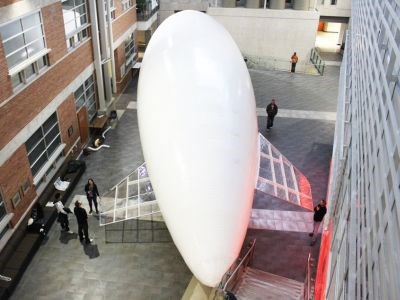Barry Prentice really, really wants to fly his airship.
The professor of supply management at the University of Manitoba’s Transport Institute and his colleagues have been awaiting the green light from Transport Canada to get their ship in the air, but the test date has been pushed back again and again.
It’s frustrating for the man who’s been researching airships as a viable transport option for the last decade.
“Imagine you’re a little kid and you’ve got Christmas on the 25th of December, and then someone comes along and says, sorry, it’s the 25th of February; no, it’s the 25th of June,” Prentice chuckled. “That date’s a little bit further out all the time.”
He may finally get his test date this summer, however, and if he does, it will mark an important step in the evolution of air transport in Canada. Prentice contends that airships are a feasible answer to get goods and services up to the far northern reaches of this country, where warming temperatures are threatening the viability of ice roads and astronomical costs make permanent roads too expensive.
In Manitoba, Prentice said, ice roads are useful for half the time they used to be, and all-weather roads are being threatened by melting permafrost, which can drop the road three to four feet below where it should be.
Airships, he argues, are reliable, inexpensive to operate, and can carry large cargo loads. If they could ferry goods to remote northern communities, people could receive fresh groceries daily, helping to reduce the cost of eating healthfully. They could transport building supplies, furniture and other household items more efficiently and economically. They could even bring goods in and out, setting people up for economic development opportunities and helping to eliminate the crushing poverty that is a reality for many in these communities.
“I don’t think we can solve the problems of the remote communities in the Canadian North without a transportation solution,” Prentice said. “Because it’s no different than the kind of poverty that was sitting here in Western Canada before the railway came through, for the same reason: if you haven’t got anything to trade, how do you make any income?”
One of those self-sustaining opportunities could be first-hand involvement in the airship industry, including the manufacture and maintenance of the airships and hangars, the piloting of the ships and the operation of the ground services.
But it requires capital investment and a little faith in the technology itself—something Prentice has discovered is easier imagined than gained when it comes to a new industry. The irony is that the industry is anything but new; airships have a long provenance in Europe and the U.S., where the military has built and will soon test an airship designed for surveillance.

Pilot Dale George, sitting in the gondola of the University of Manitoba’ airship, is an expert in airship building and designed the airship. He had to get his hot air balloon pilot’s licence before being qualified to fly airships in Canada.
To ease concerns, Prentice and his colleagues are taking baby steps towards their goal, and research will continue into cold-weather operation, ballast exchange and fuel systems “to see what works and how we can make airships that are robust and rugged for the Canadian environment,” Prentice said.
Starting out, the group will test an airship acquired in California, and from there, hopes to build its own, fairly traditional airship, featuring a simple engine design with 28 horsepower and a polyester envelope.
“Our plan, at this point, is to actually fly it by remote control first,” Prentice said. “So we’re not even going to risk anybody on board, and it’ll be tethered as well.”
The ship will be ready to fly come test day, but convincing government, private enterprise and, perhaps most importantly, the public to get on board is another matter, since Canada has no history with airships.
There is also the lingering ghost of the Hindenburg, the airship that crashed during landing in New Jersey in 1937, killing 30 people. Technology and knowledge about airships have vastly improved in the last 75 years, yet the fear persists that a similar accident could occur today.
The primary concern is over the use of hydrogen to create buoyancy, but Prentice is researching a number of options to increase confidence in its use, such as including a boundary layer to reduce the probability of fire, or the use of fuel cells instead of engines.
“I’ve been at this for over a decade now, and in the course of that time there have been lots and lots of opportunities for people to come forward and tell me they’ve got a better idea, and I’m still waiting to hear what that is,” Prentice said. “So in the absence of a better idea, I say, why aren’t we at least researching this? Why aren’t we trying to find out if it does make sense? What have we got to lose in Canada into putting some investment into finding out whether airships are a solution?”




